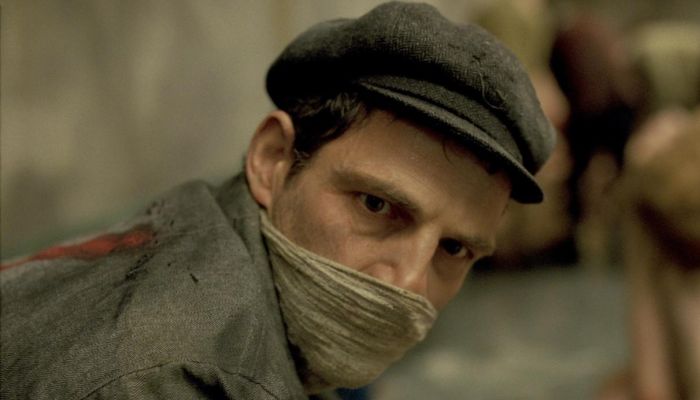 (5 / 5)
(5 / 5)
In Son of Saul, first-time director László Nemes gets us right up in the face of Saul Ausländer (poet-turned-actor Géza Röhrig).
Saul’s powerful features and dark eyes give him a sharp, watchful look. As a Hungarian Jew, and member of a Sonderkommando work unit at Auschwitz, it pays to be watchful. Being watchful keeps you out from under the boots of the guards and makes it easier to spot the glint of valuables — or “shiny” — among the clothes of the less fortunate; those shortly to become corpses (coldly referred to as “pieces”).
Saul is, though utterly against his will, a collaborator. As a matter of survival he helps shepherd new arrivals towards the gas showers and mop up the blood in the aftermath. Nemes’ use of short focus, combined with a restrictive 40mm lens, ensures that we are focused on Saul alone. We witness almost nothing outside his field of vision.
Saul’s own focus, however, is quickly turned away from the business of survival. When a young boy survives the gassing, only to have his life snuffed out a few moments later, Saul becomes fixated on providing him with a proper Jewish burial.
Whether or not Saul truly believes the boy is his son, as he claims, is seemingly irrelevant as Saul’s efforts grow increasingly risky. We observe in a series of extended tracking shots as Saul moves semi-freely around the camp, from the doctor’s surgery — to recover the body — to, in essence, the gates of Hell — to secure the services of a rabbi, of however doubtful provenance.
After the almost claustrophobic lock on Saul’s utter torso, when the camera is forced to loosen up on the edge of the flaming death pits, it only adds to the feeling of barely suppressed panic.
Though most of the atrocities take place off-screen, marked only by a gunshot, Tamás Zanyi’s sound design subtly ratchets up the tension. Mátyás Erdély’s crisp cinematography ingrains us in the dirt and sweat of Saul’s daily — often nightly — grind. The opening shot is of green grass, a scarcity within the walls: other colors are limited to brown, and olive, the pale, buttery yellow of dead flesh and the claret smear of blood.
Saul’s fellow Sonderkommando’s attempt to document the atrocities with a box camera but the machinery of death is suddenly swallowed up in thick white smoke.
The most upsetting moment, perhaps, comes when Saul is forced to perform an impromptu parody of a Yiddish dance to mocking shouts of “Mazel tov!” — a reminder that the destruction taking place is not only physical but spiritual. In an environment where the only obstacle to murder is storage space, Saul’s gambit acquires a reckless nobility, one that even the kapos — the inmates in charge of the work details, men who’ve knowingly shoveled the ashes of their predecessors — grudgingly turn a blind eye to; even if they privately feel that Saul is “letting down the living”.
Son of Saul possesses a strand of thriller DNA, but one that never cheapens the horrific milieu; ultimately asking the question of what those in impossible situations will do not just to survive but to live.
A transfixing Bruegelian nightmare of one man’s precarious place amidst the chaos and ugliness of war, the film may lack, say, the all-encompassing drama of a Schindler’s List or the sheer hauntedness of The Pianist, but Son of Saul‘s narrow scope provides for an un-sensationalized, un-sentimentalized, as-yet unseen look at life in the camps.
